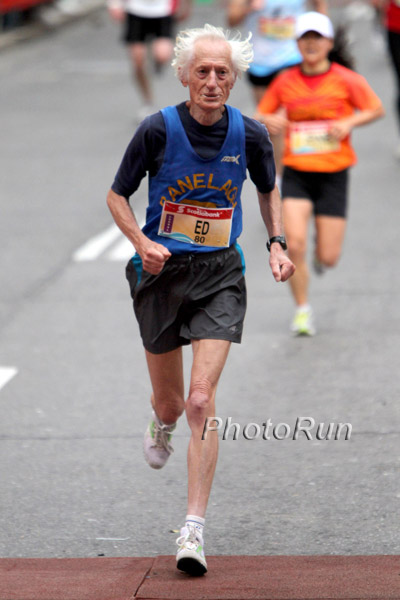Well, our friends at the University of New Hampshire, in a new study show that you can run for many years and running economy stays good as well!

RelatedPosts
Nov. 29, 2011
UNH Study: No Decline in Running Economy for Older Runners
DURHAM,
N.H. – Runners over the age of 60 are the fastest-growing group in the
sport. A new study from the University of New Hampshire suggests that
their running can remain fast as they age, too.
The
study, published in the Journal of Strength and Conditioning Research,
found that the running economy – how efficiently the body uses oxygen at
a certain pace – of older runners was no different than that of younger
runners. “That really jumped off the page. It was surprising, but in a
good way,” says lead author Timothy Quinn, who is an associate professor
of exercise science at UNH.
Yet in
general older runners are slower than younger ones, which is why races
segment competitors by age. Moderating the good news about running
economy, Quinn and his colleagues found that maintaining this running
economy came at a higher “cost” to senior runners. Their VO2 max, which
measures the body’s capacity to transport and use oxygen during
exercise, was significantly lower than their younger peers, as were
their maximal heart rates.
“For the
runners over age 60, it’s physiologically more difficult to run at that
speed, even though the absolute oxygen uptake value is the same as a
younger runner,” says Quinn. In other words, it will feel harder.
Working
with competitive male and female distance runners who had all finished
first, second or third place in their age categories in large local road
races, the researchers grouped their subjects as young (18-39 years),
master (40-59 years) and older (60 years and over). In addition to
running economy, Quinn and co-authors, who include former UNH exercise
science graduate student and instructor Michelle Manley and former
clinical assistant professor Allison MacKenzie (now at the University of
Buffalo), looked at other factors – strength, power, and flexibility —
that might explain how running performance declines with age.
The
older runners fared significantly worse than younger ones on all three
measures, helping pinpoint the sources of age-related performance
declines. Strength, in particular upper-body strength, is necessary to
propel runners uphill and to hasten leg turnover, says Quinn. Muscle
power – how fast that strength is generated – governs the speed at which
runners can change speed or direction or run up hills. And flexibility,
measured in this study with a sit-and-reach test to assess hamstring
and lower back flexibility, correlates with stride length and step
frequency.
These findings should by no
means suggest that older runners should hang up their sneakers, the
researchers say. “Strength declines with age, but you can minimize that
if you do strength training. It doesn’t take a lot to maintain
strength,” says Quinn. “We need to set up programs that enhance
strength, especially upper-body strength, and power. They’ll be better
runners for it.”
Quinn, who has done
research on running, cardiovascular function, and fitness throughout his
two-decade career at UNH, hopes to measure this same group of runners
over time, launching a longitudinal study that will shed new light on
the performance of runners as they age.
In
addition to Quinn, Manley and MacKenzie, co-authors on this study were
Jason Aziz of Concord Hospital in Concord and Jamie Padham of Husson
University in Bangor, Maine. An abstract of the study, “Aging and
Factors Related to Running Economy,” is available to download here: http://journals.lww.com/nsca-
The
University of New Hampshire, founded in 1866, is a world-class public
research university with the feel of a New England liberal arts college.
A land, sea, and space-grant university, UNH is the state’s flagship
public institution, enrolling 12,200 undergraduate and 2,300 graduate
students.
Author

Larry Eder has had a 52-year involvement in the sport of athletics. Larry has experienced the sport as an athlete, coach, magazine publisher, and now, journalist and blogger. His first article, on Don Bowden, America's first sub-4 minute miler, was published in RW in 1983. Larry has published several magazines on athletics, from American Athletics to the U.S. version of Spikes magazine. He currently manages the content and marketing development of the RunningNetwork, The Shoe Addicts, and RunBlogRun. Of RunBlogRun, his daily pilgrimage with the sport, Larry says: "I have to admit, I love traveling to far away meets, writing about the sport I love, and the athletes I respect, for my readers at runblogrun.com, the most of anything I have ever done, except, maybe running itself." Also does some updates for BBC Sports at key events, which he truly enjoys. Theme song: Greg Allman, " I'm no Angel."
View all posts


















